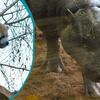London Zoo has shared adorable pictures and footage of its first 2023 arrival - a baby two-toed sloth, born on New Year’s Day.
Knowing 16-year-old sloth Marilyn was due any day, zookeepers had kept a close eye on the mum-to-be over Christmas and were thrilled to finally spot two big brown eyes peering out through her fur.
London Zoo sloth keeper Veronica Heldt said: “Having arranged regular ultrasounds with the Zoo’s vet team we knew Marilyn was coming to the end of her pregnancy, so we’ve been checking every day for any sign of the new arrival; we were delighted to finally spot a tiny baby exactly where it should be, clinging onto Marilyn’s tummy, as she curled up in her favourite tree.
“We’ve nick-named the little one Nova, which means ‘new’ in Latin, as we couldn’t have asked for a better start to the new year.”
Nocturnal mammals native to South America, two-toed sloths (Choloepus didactylus) have a gestation period of 10 to 11 months and infants are already physically well-developed when they’re born, meaning they’re able to eat solid food right away - and hold on tight to their mother.
Veronica added: “Sloth babies are very strong when they’re born and immediately find a comfy spot, hugging mum, which they won’t leave entirely until around 12-months-old. This enables them to build up the valuable muscles needed to spend life slowly swinging from tree to tree.”
Nova was also born with the two-toed sloth’s characteristically impressive claws, which will grow up to four inches in length and also help when the youngster is ready to ‘branch out’ on its own.
While Marilyn has spent her first week with Nova mostly tucked away from view, visitors to London’s famous conservation zoo may now be able to spot the duo alongside dad Leander in Rainforest Life, the only living rainforest in the city - a lush, tropical paradise, heated to 28°C all year round, which the family shares with titi monkeys, golden-headed lion monkeys and red-footed tortoises.
Keepers won’t know the youngster’s sex until confirmed by vets after hair DNA is analysed. Male or female, the newborn is a valuable addition to its species and once its sex is confirmed, its details will be added to the European Studbook (ESB), part of a coordinated breeding programme for two-toed sloths.
Ronnie added: “Every birth at London Zoo is a conservation success and a vital part of ZSL’s work preserving and protecting wildlife. The start of a new year is always cause for celebration, but the arrival of baby Nova has made 2023 extra special.”
Sloths have evolved for millions of years in a relatively stable climatic environment and are vulnerable to even small changes in temperature and weather - unlike many other mammals, sloths are unable to regulate their own body temperature, and so are particularly threatened by the global issue of climate change. As well as working on the ground to protect threatened species around the world, scientists and conservationists from ZSL, the conservation charity behind London Zoo, are urging world leaders to tackle biodiversity loss and climate change in unison in order to save our planet.
Visitors to London Zoo can hang out with Marilyn, Nova, and 14,000 other animals this January.
Related Members
-
News
 Belfast Zoo helps to bring Christmas joy to Children’s Hospital 19th December, 2025Belfast Zoo joined the Lord Mayor of Belfast, Councillor Tracy Kelly, on Monday (15th December) to help bring festive cheer to the Royal Belfast Hospital…
Belfast Zoo helps to bring Christmas joy to Children’s Hospital 19th December, 2025Belfast Zoo joined the Lord Mayor of Belfast, Councillor Tracy Kelly, on Monday (15th December) to help bring festive cheer to the Royal Belfast Hospital… -
News
 Colchester Zoological Society welcomes new arrivals 19th December, 2025This December, Colchester Zoological Society (CZS) welcomed some exciting new arrivals! A young male pygmy hippo, Mikolas, from Zoo Dvur Kralove…
Colchester Zoological Society welcomes new arrivals 19th December, 2025This December, Colchester Zoological Society (CZS) welcomed some exciting new arrivals! A young male pygmy hippo, Mikolas, from Zoo Dvur Kralove… -
News
.png?w=100&h=100&zc=1&f=jpeg&hash=8d175f93cde920c5ba23c8ea7f92e55a) Blog: Understanding the human side of zoos 16th December, 2025Why are zoo researchers increasingly looking to social science? Dr Nieky van Veggel explains the significance of understanding the human dimension…
Blog: Understanding the human side of zoos 16th December, 2025Why are zoo researchers increasingly looking to social science? Dr Nieky van Veggel explains the significance of understanding the human dimension…


